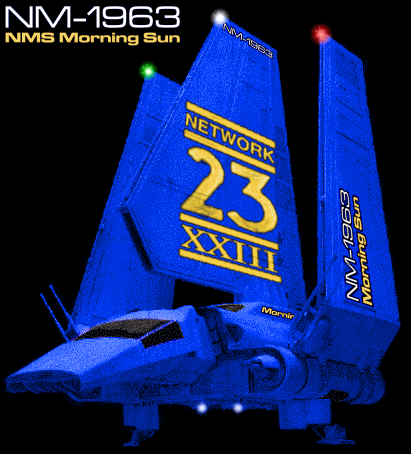
|
NMS Morning Sun
- NAME/MODEL#:
- Substance-class Courier Shuttle
(Modified Lambda-class Executive Shuttle)
- DESIGNER/MANUFACTURER:
- International Police Yards (a wholly owned subsidiary of British-AnimeTech, Limited)
(After Cygnus Spaceworks, a division of GENOM Corporation)
- COMBAT DESIGNATION:
- Armed long-range courier shuttle
- CREW:
- 2-3 (1 pilot, 1 optional navigator, 1 engineer)
- PASSENGER CAPACITY:
- 5
[STOCK: 20, or cargo]
- CARGO CAPACITY:
- 5 mt
[STOCK: 80 mt, or passengers]
- POWER SYSTEM:
- ExoSalusia FR.7c power converter and fusion reactor
Iotek 23f fusion-ion power converter
[STOCK: Iotek 23c ion power cells and ionization reactor]
- PROPULSION SYSTEM:
- Cygnus 5K2 Dual Line ion engines (rated at 1000 KTU)
[STOCK: Cygnus 4K2 Dual Line ion engines (rated at 800 KTU)]
- SPEED RATING:
- 90 MGLT
[STOCK: 60 MGLT]
- FLIGHT CONTROL SYSTEM:
- Miradyne RCS-4 flight avionics package
- MANEUVERABILITY RATING:
- 71 DPF
- NAVIGATION:
- British-AnimeTech HyperStar-II computer system
[STOCK: GENOM N-s8.6 Navcon computer system]
- FTL:
- CEC 2240.402c motivator drive unit (hyperdrive)
[STOCK: Cygnus HD4 motivator drive unit (hyperdrive)]
- WEAPONS:
- 2 Gyrhil R-9X naval turbolaser cannons (fire-linked)
4 GENOM L-s9.3 blaster cannons (2 forward, 2 aft)
2 Borstel NK-5 ion cannons (single fire or fire-linked)
2 GENOM M-g2 General Purpose Warhead Launchers
[STOCK:
Ten Taim & Bak KX5 blaster cannons (8 forward, 2 aft)
2 GENOM M-g2 General Purpose Warhead Launchers]
- SHIELDS/ARMOR:
- Forward/Rear Projecting ExoSalusia shields (rated at 250 SBD)
Composite reinforced titanium-polyalloy hull (rated at 40 RU)
[STOCK:
Forward/Rear Projecting GENOM shields (rated at 100 SBD)
Titanium-polyalloy hull (rated at 23 RU)]
- SPECIAL EQUIPMENT:
- British-AnimeTech CryptoSpec secure communications system
GENOM Multicore 4400 computing module (Al)
[STOCK: none]
|
|
The Morning Sun began its career as a Cygnus Spaceworks Lambda-class
Executive Shuttle, the Learjet of the 24th Century. Though a decently
speedy and quite maneuverable ship with a fairly powerful shield
generator, the stock Lambda class was clearly unsuitable for the
transport of a traveling reporter team - it had no living quarters,
and its performance, though more than adequate for the sedate
corporate travel it was built for, could stand improvement for the
rush-and-tumble of cutting-edge journalism. Shortly after purchase,
the shuttle was taken to the newly opened International Police Yards
of British-AnimeTech, Limited, an engineering firm founded and still
occasionally run by WDF core veteran Ben "Gryphon" Hutchins, for
upgrading.
Since the Morning Sun's owner was one of Gryphon's oldest
friends, Gryphon took a personal interest in the project. He had
another reason to get involved, as well: he was in the process of
developing and standardizing equipment for the International Police
Organization, commonly nicknamed the Experts of Justice. The
Experts were in need of a small, fast, sturdy class of starships to
carry their two-agent field teams into action, one less obviously
threatening and militarized than the 3WA's standard
Predator-class scoutships (which, being a scaled-down version
of the famed Klingon B'rel-class escort, is nothing if not
obviously threatening and militarized). The Morning Sun would
be the prototype for one such class of ships, which was to be dubbed, as
the project went on and the changes to the Lambda class's
specification became manifold, the Substance class.
(Zefram Cochrane's parallel effort within the IP Yards, the
Kennebec class - a modified, uprated Utopia Planitia
Danube-class runabout - would prove successful as well, but
that is another story.)
Following is an excerpt from Gryphon's report to Truss on the final
modifications, delivered as the prototype, major modifications
completed, was being run through the final fit and finish adjustments
before delivery to the customer:
The Corellian Engineering 2240.402c hyperdrive motivator is the same
one used in such infamous converted hot-rod freighters as the
Millennium Falcon and my own Daggerdisc - ships several times
the mass of the Morning Sun. That may well make the Morning Sun and her
sisters the fastest hyperdrive-equipped starships in the galaxy. The
really tricky part of the drive conversion was getting Iotek to make a
fusion-ion converter up to the 23c spec, but that was necessary,
because changing out the Dual Line ion drives would be an obvious
exterior change to the ship, and since we wanted a total sleeper we
didn't want that. Unfortunately, Cygnus doesn't make Dual Lines
much more powerful than the ones that come stock, so the sublight speed
increase after modification isn't as impressive as the hyperdrive
boost. Oh well. Maybe Cygnus will come up with a 6 or 7K2 DL one of
these days. If they do, you'll be in for a refit. :)
Similarly, we couldn't do as much with the hull strength as we'd
hoped, without running into performance-diminishing weight gains or
altering the ship's outer appearance. The Lambda class's elegant
looks mean that there will always be parts of the hull that just can't
be made as sturdy as I'd like, but then, I like 'em really thick. The
shield boost was hung way out on the bleeding edge in order to
compensate for that.
The weapons loadout is based on the theory that you're going to try to
avoid combat, but if you have to do it, you want to be able to kick
the enemy hard enough in the teeth that you'll be able to run away
while he's holding his mouth and swearing. That's where the
turbolasers come in. Those are capital-ship weapons cunningly
camouflaged into the medium-blaster ports sticking out of the
wingroots. These weapons are mounted on only two other vessels in the
universe the Lambda's size or smaller: the B-wing and Colonial
Vipers. You can't be recharging your shields or your smaller weapons
while the turbos are online, but you can blow off a cap-ship's
tractor-beam projector and beat it into hyperspace - or at least,
that's the theory.
The smaller weapons are little changed from the standard loadout - we
used the laser cannons spec'd for the TIE Advanced instead of the Taim
& Bak KX5 because we had them handy and they're a bit more powerful,
and switched two of the wing-turret guns (the inboard pair) for ion
cannons in case you need to disable something rather than blow it up.
The CryptoSpec comm scrambler is for secure communication with Experts
of Justice HQ - I know you and Jung aren't active agents, but if you
ever have to be activated in a hurry, we want to be able to turn the
key and go, not spend two days installing new comm gear in your ship.
The downside of all this cool gear is that you lose your
passenger/cargo space. There was some space left over after the mods,
but that was converted into living quarters - remember, the Lambda
class wasn't designed for its crew to live aboard. There are small
staterooms for both human crew members, a droid bay, galley,
wardroom/lounge, and of course a head, in addition to the control deck
and the engineering access spaces. The wardroom seats five if you
really need to haul passengers.
Keep in mind that a lot of this ship's equipment - the ion cannons,
which are considered weapons of piracy in a lot of places; the turbolasers, which are
strictly military hardware; the CryptoSpec, depending on what
encryption laws are like in the part of the universe you're in; the
cap-ship hyperdrive in a ship of that tonnage - is illegal. A good
deal of work went into disguising and concealing the true extent of
the modifications, but there's no disguising the fact that the cargo
hold is gone. The upshot is that you'd be well-advised to keep
government inspectors out of the engine spaces.
|
|
The Crew
|
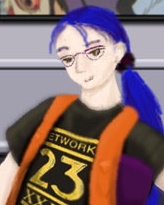
|
John Trussell
|
|
RACE:
Human (Detian)
AGE:
432
HOMEWORLD:
Earth
PLACE OF BIRTH:
Earth
(U.S.A.)
|
John (or "Truss," as he is more commonly addressed) is one
of the original Wedge Rats. He was a member of the Wedge Defense
Force at its inception in 1992, though he kept a reasonably low
profile within the organization. Early in his career, he served as a
ships engineer; in later years, he moved on to other roles in search
of one that truly resonated with him.
Over the intervening centuries, he has been a WDF communications
and systems officer, a television news reporter, a starship captain
(WDF Pennsylvania, 2388-2404), and now he's returned to the
airwaves as the host of Earth-based Network 23's second-highest-rated
news program, Network 23 Action News with John Trussell - more
commonly known among his legion of fans as The Truss Report.
Truss is one of the best-trusted figures in modern broadcast
journalism, second (according to numerous independent studies) only to
his boss, Network 23's News Director, the legendary Edison Carter.
In fact, since Carter prefers to run his news department from the
trenches, as it were, he and Truss and their respective support teams
have a long-standing (dating back to Truss's original time with Net23
in the 24th century) unofficial rivalry over ratings, demographics,
and the overall juiciness of stories. This has led to some
speculation that the two men do not get along off-camera, which
couldn't be further from the truth; after all, if Truss didn't get
along with his boss, he wouldn't keep his job.
|
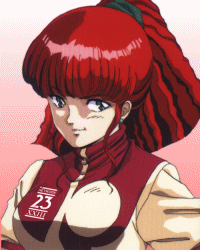
|
"So, this is it, huh? A Lambda shuttle?"
"That it is."
"Thrilling. The ace fighter pilot is reduced to driving a bus.
I don't suppose you've made any custom mods at
all?"
"Nope..." [slaps a credit chit into Jung's
hand] "...that's your job. That chit is your budget. Go
wild, throw in whatever equipment will help you do your job, but make it
good. Because after costing me that many credits,
you're not allowed to complain about the ship for at least a month."
Jung-Freud
|
|
RACE:
Human
AGE:
23
HOMEWORLD:
Earth
PLACE OF BIRTH:
Earth
(Russian Federation)
|
Jung-Freud first met up with Truss on the WDF Pennsylvania, where
she served as the pilot of one of that vessel's small complement of
Cygnus Xg-1 Star Wing assault gunboats. It is likely that Jung-Freud is
not her birth name, but there are no records to prove otherwise, and she
isn't telling. It's the only name she responds to, regardless.
Jung is a pilot of remarkable ability. Unfortunately, she is
also remarkably headstrong, stubborn, occasionally lacking in common
sense, and has never considered tactfulness to be of any
importance whatsoever. Those personality traits sparked more than a few
conflicts with her supervisors and her peers. But (luckily for her)
Captain Trussell was even more lenient than most WDF officers -- and was
willing to overlook her brashness so long as she kept getting results.
When Truss left the WDF, Jung had a hard time finding a commander
who was willing to put up with her. Eventually, she got herself
thrown out of the Force (and even in the more formal 25th-century version,
it takes talent to get thrown out of the Wedge Defense Force)
under mysterious disciplinary circumstances, and wound up taking the
job as Truss's pilot with Network 23.
Jung respects Truss (and vice versa), but Jung isn't about to cut Truss
any more slack than she'd give anyone else. Their dynamic on the bridge
(and over the comlink, since Jung is in constant communication with both
Truss and Al, his controller ACI) would appear volatile to an outside
observer, but anyone who knows them both well would be able to see through
appearances. They trust each other with their lives - every day.
|
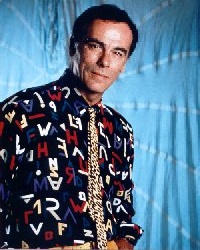
|
"Well, that source wasn't much help."
"Yeah, and I've met Mynocks with better personalities. She reminded
me of my third ex-wife."
"Al, you're a computer. You've never been married."
"No... but I've been programmed to think and act as if I had been.
It's a feature designed to help humans relate to me, and make them feel
more at ease."
"The male ones, anyway."
"I resent that."
"And I resent your shirt."
"I'll have you know that this garment was created by one of the
foremost designers of our time. It's the pinnacle of fashion."
"On Funkotron, perhaps."
Al
|
|
RACE:
ACI
MANUFACTURER:
GENOM (STACIS Protocol)
AGE:
3
|
Al is an
autonomous cybernetic intelligence. He became sentient on May 20, 2402,
at the Network 23 cybernetics lab in Sydney, Australia. Because FTL
communication is fairly expensive and can be unreliable at the fringes of
the relay network, Network 23 decided to assign each of its interstellar
correspondents an ACI to serve the role of controller. While some
reporters (Edison Carter among them) have found working with a computer -
no matter how intelligent - difficult to deal with, the practice has
achived a high level of popularity in recent years. (Enough so that even
a few Earth-bound reporters have begun to use ACI controllers.)
An ACI controller has several advantages over a human. First, it can
process information much more rapidly than any person possibly could.
Second, a powerful enough machine intelligence can unlock that warehouse
door, watch your back, perform that research that you needed, tell you
what's around the next corner, and place an order at
that Del Taco in the next system you'll be stopping by - all at the same
time. Third, it allows a level of interaction between reporter and
controller never before possible.
The primary piece of equipment for an interstellar correspondent is a
multi-purpose wraparound visor. This visor serves as a miniaturized
vidicam, a commlink, a heads-up sensor array, and a Direct Retinal
Holographic Projection system. The DRHP system allows Al to insert
himself into the wearer's frame of reference. Studies have shown that the
illusion of companionship reduces a reporter's stress level, and causes
them to think more clearly. Also, the combined audiovisual stimuli have
proven more effective than audio-only when the ACI has found it necessary
to get his partner's attention - right now.
More recently, Network 23 has experimented with the idea of implanting a
sensory simulator (which would serve the same purpose as an external DRHP
mechanism) directly into the reporter's brain. Needless to say,
candidates for this unorthodox operation have not been lining up around
the block, but there have been enough volunteers to call the project a
success (so far). Truss was one of the first to undergo the treatment,
and has had few complaints... save, perhaps, for the inability to turn off
the implant in order to avoid the sensory onslaught of Al's latest
holographic ensemble. (An enhancement request has been filed in the
Network 23 bug tracking database, and project leader Bryce Lynch has
assured Truss that a software upgrade should be available Real Soon Now.)
Al himself has a loyal and affable - if mildly eccentric - personality.
He has, for some reason, been programmed to identify himself as "Rear
Admiral Albert Calavicci, USN (Ret.)." And for reasons known only to Al,
he refers to a series of fictional ex-wives as though he realy were the
middle-aged human that he appears to be. (Whether these false memories
were implanted by Network 23 technicians or dreamed up by Al himself, no
one knows... Bryce claims that he had nothing to do with it.)
Al's relationship with the rest of the Morning Sun's crew is hard
to define. He and Truss certainly get along - it'd make for a positively
miserable experience if they didn't - and his attitude generally remains
positive, even when he's trading barbs with the others. His patience can
run a bit short, however, especially when dealing with the ship's droids.
(He's hypocritical enough to state that machine intelligences annoy him.)
Watching Al attempt to direct ("shepherd" may be a better term)
the ship's mechanical security detachment is particularly comical... but
don't let Al catch you laughing.
|
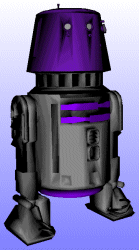
|
"So, are you going to want any pit droids or maintenance droids
for your ship?"
"I was thinking more along the lines of an astromech,
actually."
"That's gonna cost you more than you're willing to pay.
Unless... Hey, Ted! Do we still have any of those R5 units from that
shipment last year?"
"We still have all of those R5 units from that
shipment last year, Stan. In fact, we will always have
all of those R5 units from that shipment last year."
"Ah."
"Ok, how much will that cost?"
"Just take it."
| |
--Truss and the salesguys at Big Zorbo's Saucer City
|
R5-T1 ("Rusty")
|
|
MODEL:
Industrial Automaton R5 Unit
OWNER:
John Trussell
AGE:
1
|
In recent decades, Industrial Automaton has represented the state of the
art in droid design. They are the undisputed leader in the astromech
droid market, and have been ever since the debut of the spectacularly
popular R2 unit. The R series has continued to evolve over the years,
with the extremely specialized R7 recently going into mass production (and
the revolutionary Q9 unit now in alpha test). And every step
along the way has been well received in the marketplace...
...except for the R5. Witness the following, excerpted from The
Essential Guide to Droids:
How do you fix what isn't broken? Answer: you
don't. Industrial Automaton tried anyway with the R5, resulting in its
first true astromech flop.
The R5 was commissioned with no specific market or function in mind...
The company had created a new droid not because customers wanted one, but
simply because they could.
One word described the R5: cheap. That simple word,
however, was interpreted quite differently by dealers and consumers. The
former pointed out that the R5 was the least-expensive astromech in the
marketplace; the latter responded that a shoddy, shabby, inferior droid
like the R5 wasn't worth half that price even on its best day.
It didn't help matters that the model's behavioral circuitry matrix was
prone to unwelcome glitches over time, causing many R5s to acquire caustic
and disagreeable personalities. Buyers also reported problems with
chronic overheating, jammed servos, loose bearings, and blown motivators.
After a few lamentable sales seasons, each one worse than the last, IA
quietly retired the R5 line... While the droids could be purchased in
bulk for next to nothing, their one-jump hyperspace capacity made them
nearly useless as starfighter counterparts.
This sparkling review aside, R5-T1 (or "Rusty," as he was
quickly dubbed) serves quite effectively as the Morning Sun's
onboard mechanic. His personality matrix hasn't shown any signs of
turning sour so far, despite Al's opinions and treatment of the little
droid. ["Truss, your beloved R5 unit has begin
the slide into stubbornness and dementia." "No, Al, he
just doesn't like you." "A sure sign
of dementia, if ever there was one."] Over time, Al and Rusty
have come to something of a silent accord... in private. In public, the show
never stops -- Al belittling the R5 unit's "illustrious
heritage," and Rusty playing dumb in the most obvious manner
possible, just to irritate the ACI.
Truth be told, it's a good thing for Rusty that Truss
didn't know much about the R series when he bought him
(along with the Morning Sun itself). He had simply been intrigued
by astromech droids in general ever since he worked with a P2 (the
earliest predecessor to the R series, a gargantuan droid that looked like
a 300% scale model of an R2 unit) on the SDF-17 many years before. If he
had been fully aware of the R5's history (and if he hadn't been in a
"buy stuff now, worry about the budget later" state of mind at
the time), even his imp of the perverse and love for obscure technological
footnotes would not have prompted him to make the deal.
Nonetheless, now that the deal has been made, Truss has
become quite fond of his mechanical helper. Whether his good treatment of
the droid is to thank for Rusty's better-than-average disposition is up
for debate. (Truss would say yes, Al would say no, and Jung has no
particular opinion -- she's just amused by the petty bickering.)
|
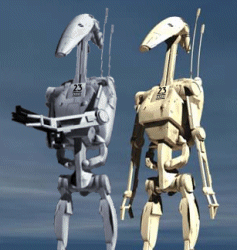
|
"So, you two are battle droids? What are you doing here?"
"We are programmed to protect Network 23 property and
personnel."
"Fair enough. Which one of you is in charge?"
"We are to defer authority to all Network 23 personnel. Neither of
us is designed to give orders to the other. Our operating parameters
are identical, within a tolerance of 0.003%."
"Doesn't that get confusing when the two of you are operating alone,
and have different ideas about what to do?"
[G-3N3 turns to look at R-06R, who
shrugs]
"Ideas?"
G-3N3 ("Gene") and R-06R ("Roger")
|
|
MODEL:
Baktoid Armor Workshop
MkII
Battledroid
OWNER:
Network 23
AGE:
1
|
During the War of Corporate Occupation, statisticians (and producers,
and controllers, and everybody else with eyes) began to notice an
alarming trend among the field reporters of Network 23: they were
getting wounded and killed much faster than they had before the entire
planet was engulfed by war. An obvious conclusion, yes, but it
spurred 23 to place security personnel with their field reporters.
This reduced reporter attrition and kept them on the air, but the
security personnel tended to die in their places, so the efficiency of
the scheme was perhaps questionable in human terms. After the war,
when most of Earth's surface was again peaceful, this practice was
largely abandoned.
As Network 23 started expanding into the offworld markets and sending
reporters offworld, though, it was soon discovered that significant
parts of the galaxy at large were not as safe as Earth. Mishaps began
to befall offworld reporters at a rate once again considered upsetting
by management. Eventually, Chief Executive Officer Ben Cheviot
reinstated the security policy for reporters assigned offworld.
The next problem to arise was simple: adding two or three people to
the crew of each of Network 23's one-reporter field units added two or
three people's worth of expense to each unit's operating budget. With
Network 23's rapidly expanding presence abroad, this state of affairs
would soon become impossible to justify financially - but the network
couldn't go back on its promise to protect its reporters, either.
Enter the Baktoid Armor Workshop, a Neimoidian corporation from the
Trade Federation. Baktoid's parent company, the Neimoidian megacorp
ZikZak, was a major sponsor of Network 23, and its president, Ped
Xing, a personal friend of Cheviot's. Learning of the network's
plight, Xing offered Network 23 a deep discount on one of the Baktoid
Workshop's major products: the Model A Battledroid.
Cheviot was pleased by the offer, but dubious about its use to him.
Originally developed as a robotic soldier, the Model A was not a true
automaton - each battledroid had to be individually directed by a
centralized regimental control computer broadcasting an encrypted
command signal. Practical on a planetary scale, perhaps, but not for
the sort of far-flung operations Network 23 would need security
personnel for. Xing assured Cheviot that this would be no problem -
Baktoid would allow Network 23 to be the first customer for the new
Model A Mark II battledroid, which was fitted with a positronic brain
sublicensed from the newly-reorganized GENOM Corporation.
With this enhancement, the MkII looked perfect for Network 23's needs.
It would be capable of independent action, without the need for a
control signal; it could easily be programmed for a security role; it
would be unquestioningly loyal to the network and the crew it was
assigned to protect, and could not be frightened or bought off like an
organic guard; and it was faster to repair and cheaper to replace,
morally and financially. Cheviot signed the deal with enthusiasm, and
within six months, every Network 23 team stationed off Earth (and some
in Earth's own still-dangerous zones) was issued a pair of MkIIs.
Even with their positronic processors, MkII battledroids are not
hyperdrive researchers. They do not generate a Spengler flux and are
not particularly creative or quick-witted. They are permanently
programmed with a wide range of security and combat techniques, making
them very effective in their designated roles, but they do not adapt
well outside that role. Battledroids - or, as Network 23 likes to
call them, "Field Assistance Droids" - do not "think outside the box".
To help them overcome this handicap at least partially, they are
equipped with five subprocessor slots in their backs, which can accept
chip-sized subprocessor modules containing additional skills, similar
to the cyberware skillset modules that are available for
cybernetically enhanced organics. Thus, a MkII can be equipped with
an adjustable range of secondary skills to meet changing mission
requirements. Most of the modules available are also combat-oriented
(specialized demolitions, combat piloting, field medicine), but some
are not (heavy metal guitar, French cookery).
The good ship Morning Sun is graced by the vigilant presence of G-3N3
and R-06R, more commonly known to their human charges as "Gene"
and "Roger" (or, occasionally, "the Beagle Boys").
Gene and Roger are unexceptional - that is to say, they are everything a MkII
security-type battledroid is supposed to be: sturdy, reliable,
competent, and rather dense. They haven't developed much in the way
of personality differentiation, though that will come with time if
they are not periodically memory-wiped. They do have rudimentary
personalities, but since those personalities were created by poorly
informed Neimoidians in an attempt to make their human customers feel
"more comfortable" with the droids, they equate to normal human
personalities in about the same way that the translated instruction
booklets for Taiwanese stereo equipment equate to Standard. Truss
finds himself rather liking them; Jung ignores them unless their
services are needed; Al tolerates them; Rusty seems to enjoy their
company.
|





